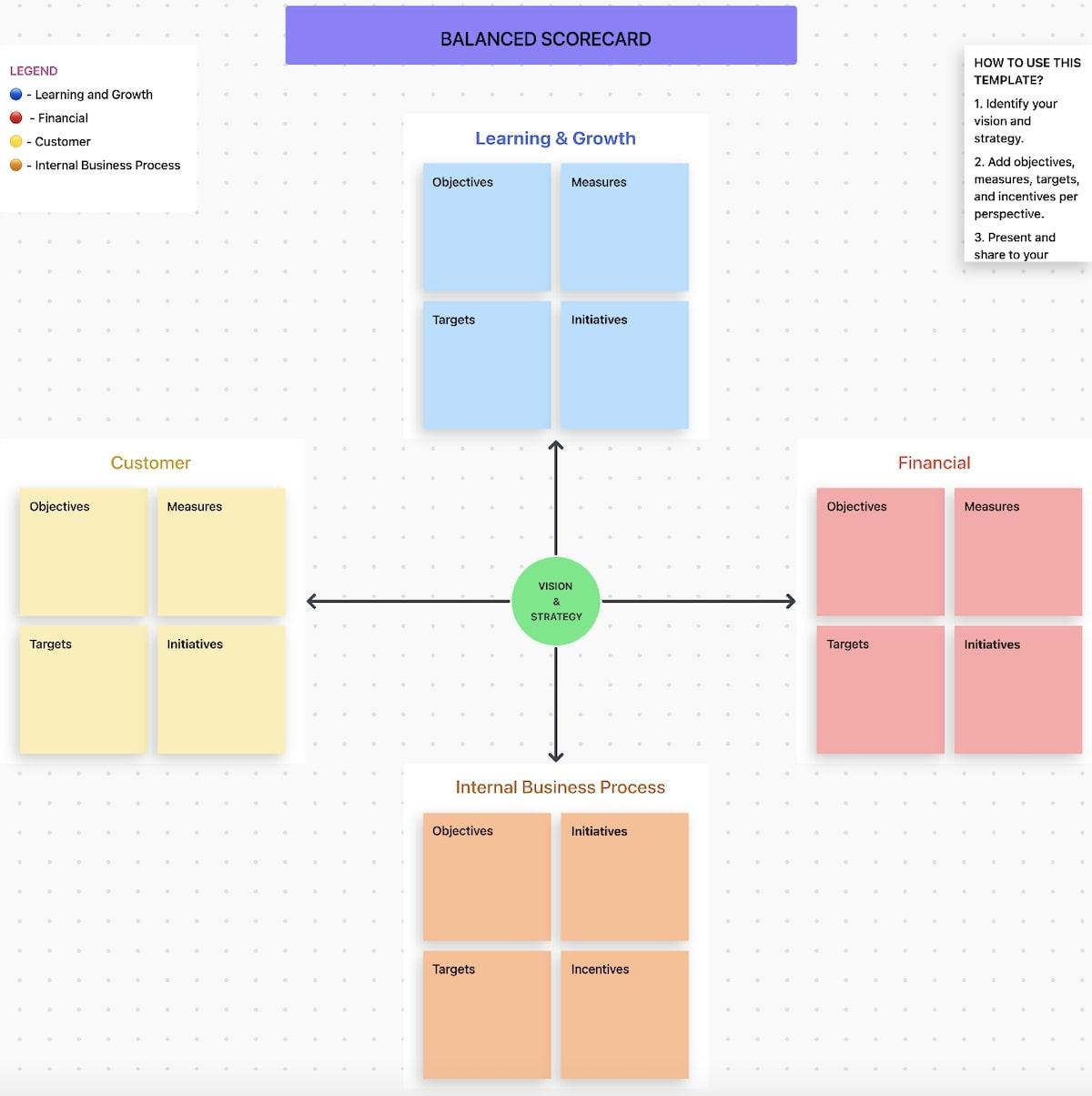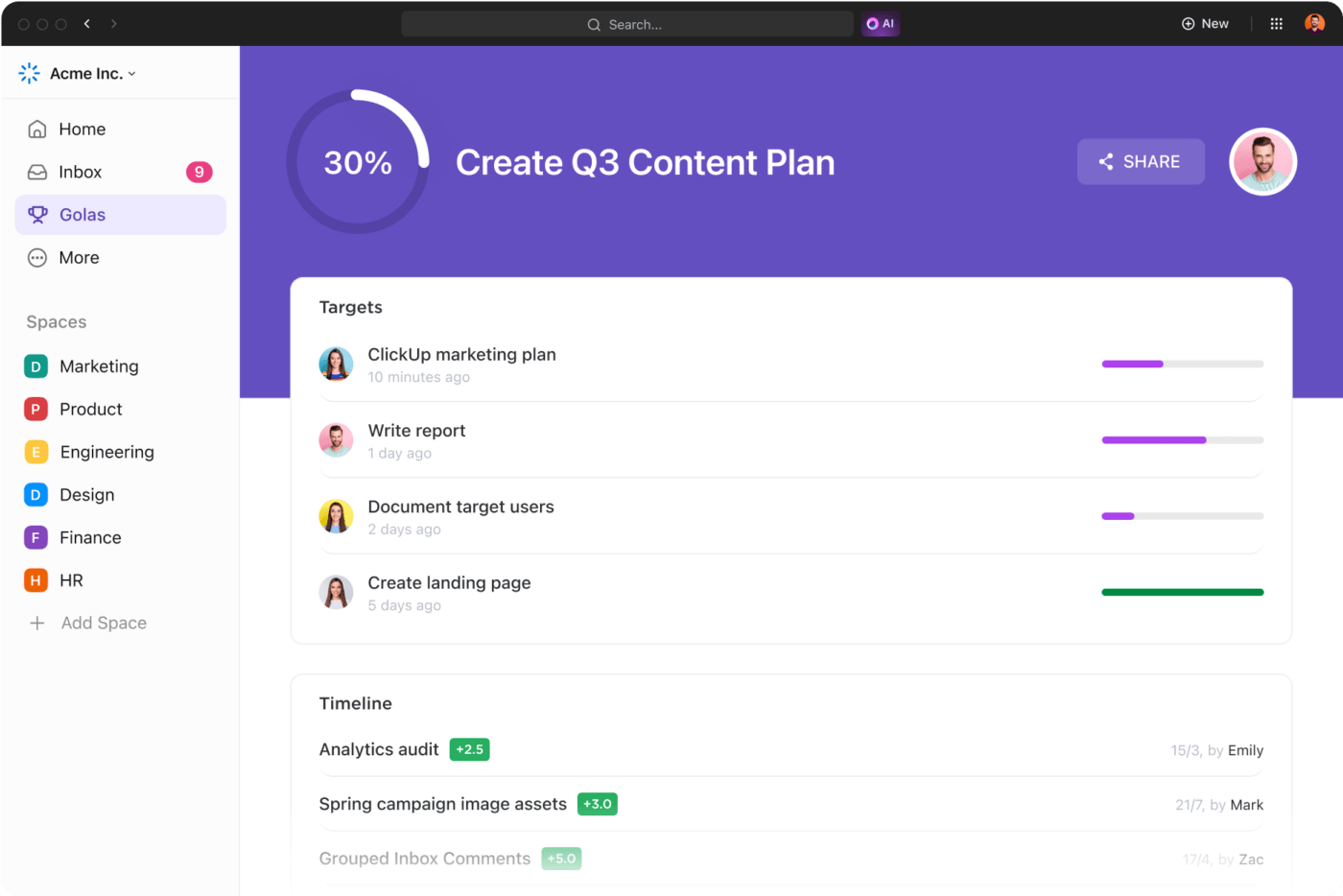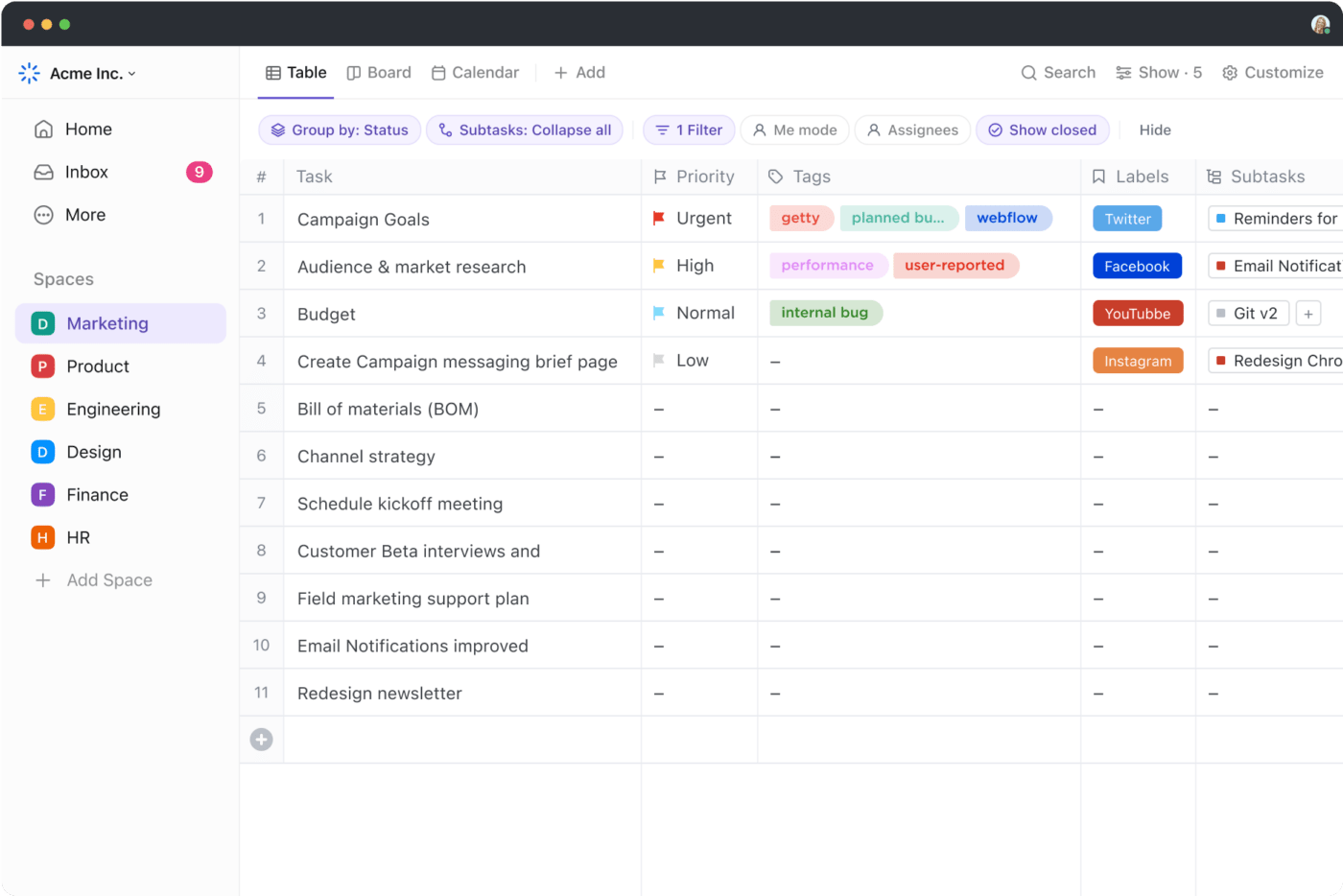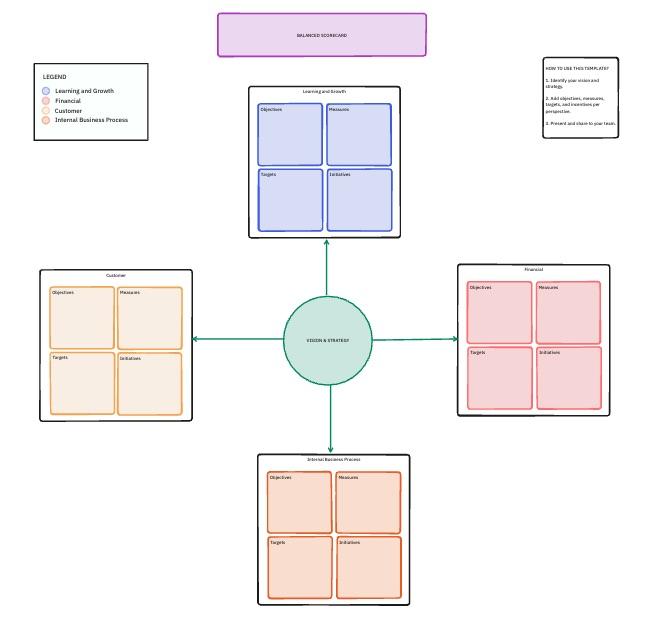In their groundbreaking 1992 Harvard Business Review article, The Balanced Scorecard: Measures that Drive Performance, professors Robert S. Kaplan and David Norton proposed a new way to measure organizational performance. 📈
The new approach, aptly named the Balanced Scorecard (BSC) framework, allowed organizations to develop a holistic set of key performance indicators (KPIs) by answering four main questions:
- What do customers think about you?
- What do you need to be really good at?
- Can you keep getting better and making money?
- How do your shareholders see you?
In this article, we’ll discuss the fundamental concepts of the Balanced Scorecard framework, its main benefits, and key components. We’ll also show you how to build a balanced scorecard for your organization with valuable tips and best practices. Lastly, we’ll share a few balanced scorecard examples in the manufacturing, retail, healthcare, banking, and technology industries.
What Is the Balanced Scorecard Framework?
The Balanced Scorecard framework is a strategic planning and management system designed to capture a wide range of performance metrics, from financial performance to operational benchmarks, customer satisfaction indices, and learning and growth measures.
The framework offers a subtle yet powerful approach to measuring organizational performance. Unlike traditional performance measurement models, it’s an integrated system that doesn’t focus solely on financial metrics. Instead, it provides a balanced view of your organization’s health by taking into account critical non-financial aspects.

Let’s take a closer look at the four perspectives of the Balanced Scorecard framework.
1. Customer perspective
Nowadays, business success is often defined by customer satisfaction. Most organizations consider their mission to be the best at giving customers what they want. So, it’s crucial for top managers to know how well they’re doing from the customers’ point of view.
The Balanced Scorecard instructs companies to take their general goal of good customer service and break it down into specifics they can measure. These usually boil down to four key metrics:
- Time
- Quality
- Performance
- Cost
The time component pertains to how long it takes from the moment a customer orders something to when they actually receive it. Quality is often expressed as the absence of defects, while performance and service measure how well the products or services add value for customers.
Bottom line: To use the Balanced Scorecard to gauge success from the customer perspective, you need to set goals for time, quality, performance, and service, and then find specific ways to measure these goals.
2. Internal perspective
While it’s important to know how happy your customers are, it’s equally important to identify various internal business functions necessary to maintain customer satisfaction. After all, good customer service stems from a company’s inner workings.
Internal metrics in the Balanced Scorecard should focus on the business processes within the company that have the biggest impact on keeping customers happy. This includes how quickly products are made, how good they are, the skills of the employees, and how efficiently everything runs.
To determine what to measure internally, companies should identify the processes and skills essential for success and set goals for each. For example, they might decide that being fast at making products is crucial, so they’ll measure their production speed.
Given that many critical activities occur at lower levels of the organization, managers should divide these major objectives into smaller, actionable goals for employees.
Information systems are really helpful here. If something unexpected shows up in the balanced scorecard, managers can use these systems to determine what’s causing the problem. For instance, if the overall measure for delivering products on time is subpar, managers can dig into the system to pinpoint bottlenecks.
3. Learning and growth perspective
The Balanced Scorecard looks at how well a company is doing from two angles: customer satisfaction and internal processes. But what counts as success isn’t set in stone. Nowadays, with fierce competition globally, companies need to keep getting better. This means improving current products and processes and even coming up with brand-new, better products.
A company’s ability to constantly generate new ideas, optimize them, and learn from mistakes is crucial for its success. This directly affects the company’s ability to create value. Only by constantly improving and innovating can a company grow, attract more customers, and make more money, which leads us to the final perspective of the Balanced Scorecard.
Pro tip: Take an organized and systematic approach to crafting your improvement strategy. Leverage the ClickUp Continual Improvement SOP Template to standardize the processes that go into making your product or service better.

4. Financial perspective
The financial perspective of the Balanced Scorecard is all about how the company appears before its shareholders. This means looking at profit, growth, and overall value. 💸
Financial health has traditionally been the primary indicator of business performance and alignment with strategic goals. However, Kaplan and Norton argue that although necessary, traditional financial measures like quarterly sales and profits don’t give a complete picture of how well a company is doing.
There’s also the opinion that financial metrics only look at the past and don’t consider what a company is doing right now to create value, so they need to be viewed together with the other three performance perspectives of the Balanced Scorecard.
Benefits of Building a Balanced Scorecard for Your Business
The balanced scorecard is a must-have for businesses aiming to grow in a smart and sustainable way. This performance assessment tool enables companies to see the big picture, track progress, and make intelligent decisions based on facts.
According to a survey, 80% of organizations using balanced scorecards reported improvements in operating performance. It sounds amazing, but there are other benefits too. Let’s check them out. 👇
1. Better strategic planning
Implementing the Balanced Scorecard framework in your operations can boost your planning for the future. It includes a strategy map, which visually represents how different parts of your business strategy are connected and gives you a clear picture of how well your company is doing from various perspectives, not just financial.
Here are some of the ways in which the Balanced Scorecard approach can improve your strategic planning:
- Improved decision making: Leaders can use the performance data collected from various perspectives to identify risks, trends, and opportunities and make better decisions
- Identifying and fixing problems quickly: You can easily spot issues and deal with them systematically. For example, if you see that customers aren’t as happy as they used to be, you can figure out why and fix the problem before it escalates
- Encouraging continuous improvement: By regularly tracking performance across different areas, the Balanced Scorecard fosters a culture of continuous improvement. For example, if you see that a particular process isn’t working as well as it should, you can brainstorm ways to improve it and then track if those changes are making a difference
Pro tip: You don’t have to start from scratch if you use the ClickUp New Business Strategic Plan Template. It lets you easily define your vision and set clear goals for your team to strive for.

2. Improved communication
Implementing the Balanced Scorecard framework not only helps you design your business strategy better but also improves communication in your company. Working together is more manageable when everyone understands the company’s objectives and their role in reaching them.
With the Balanced Scorecard, team members can share ideas and give helpful feedback, which can improve problem solving. It also ensures everyone knows what’s going on at all times, reducing confusion and friction.
3. Better organizational alignment
Creating a balanced scorecard doesn’t just improve communication; it also ensures alignment toward shared objectives. Here are some specific advantages:
- Enhances focus: When they understand how their work contributes to the overall objectives, team members can focus more effectively on essential tasks
- Improves efficiency: When processes align with the overarching objectives, time is used more efficiently and there’s less waste
- Promotes adaptability: Clear direction enables better preparation for and adjustment to changes
- Boosts employee satisfaction: When employees see how their work helps the company, they tend to feel more motivated and deliver higher-quality work
4. Clear representation of objectives and goals
Using a balanced scorecard for your business is like ensuring everyone knows the game plan and their role in it. It’s not just about setting goals and objectives; it’s about making sure everyone understands why those goals and objectives matter and how they fit in.
For example, imagine your company’s objective is to boost customer satisfaction. With a balanced scorecard, everyone, from the customer service team to the software developers, knows their job impacts customer satisfaction. So, they can focus on doing their part to make customers even more satisfied.
5. Enhanced performance measurement
One of the best things about this framework is that it helps you figure out what really matters—those key performance indicators (KPIs) that show if you’re on the right track. You can actually measure how content your customers are, how smoothly the processes are running behind the scenes, and how much your team is evolving.
And here’s the best part: It’s not a one-time thing. You can keep checking your progress, fine-tuning your approach, and improving processes across the board.
6. Clarity of priorities
Setting priorities is an integral part of building a balanced scorecard. They help organizations know where to invest their time and energy. By figuring out what needs the most attention, businesses can ensure the alignment of initiatives with their primary objectives.
7. Culture of accountability
Imagine you’re the CEO of a marketing agency, determined to improve performance and achieve ambitious growth targets. So, you use a balanced scorecard.
Transparency becomes paramount. You hold a company-wide meeting to outline objectives such as increasing client satisfaction, generating more leads, and improving campaign effectiveness. Each team member understands their specific role and goals, whether it’s creating compelling ad copy, optimizing social media campaigns, or analyzing market trends.
The balanced scorecard serves as a performance-tracking tool during weekly team meetings. You monitor vital metrics like client retention rates, lead conversion rates, and campaign ROI. This allows you to identify areas needing improvement and recognize top-performing teams.
By clearly defining roles and responsibilities, the team becomes more engaged and motivated. Each member understands how their contributions impact the agency’s success, fostering a sense of ownership and commitment.
Pro tip: Guide your team with the ClickUp Project Management Roles and Responsibilities Template. Clearly define roles and assign tasks while maintaining accountability and healthy communication.

When to Build a Balanced Scorecard?
So, when’s the right time to build a balanced scorecard for your business? It’s an important question to ask because timing can significantly impact the success of this strategic planning and management tool.
It’s not about a specific date on the calendar but rather about recognizing the signals that your company is ready to benefit from the framework. Here are a few signs that it might be time to start building a balanced scorecard:
- You’re struggling to align your team’s daily activities with your strategic goals: A balanced scorecard helps to bridge this gap, translating high-level objectives into measurable actions
- You find it challenging to monitor your company’s performance across multiple areas: The balanced scorecard provides a comprehensive picture, covering financials, customer satisfaction, internal processes, and learning and growth
- You’re finding it hard to communicate your strategy effectively:The balanced scorecard serves as a communication tool, helping everyone in your company understand and work towards shared objectives
- You’re not seeing the expected results from your strategic initiatives: A balanced scorecard can help you track your progress toward your objectives, identify areas where you’re falling short, and make necessary adjustments
What to Include on a Balanced Scorecard?
Crafting a well-rounded balanced scorecard requires careful consideration of key elements across four critical business perspectives. Each of these perspectives must be clearly defined and measured to ensure you’re tracking progress toward your strategic objectives.
Here’s a simple breakdown of the key elements of a typical balanced scorecard:
- Objectives: These are high-level goals that define what the organization aims to achieve strategically. For example, Become an internationally-recognized brand. Typically, every business has 10-15 strategic objectives
- Goals: They are more specific, measurable, and time-bound targets that make up the broader strategic objectives. For the objective in the previous point, a goal would be to increase sales in foreign markets by 15% by next year. There are typically more goals than objectives
- Metrics: Metrics or indicators help assess whether objectives are being achieved strategically. An example of an indicator would be the total value of international sales. Each objective may have 1-2 measures, totaling around 15-25 measures at the enterprise level
- Initiatives: These are action programs designed to accomplish objectives. They can be referred to as projects, actions, or activities outside of the balanced scorecard context. Generally, organizations have around two initiatives underway for every objective, with 5-15 strategic initiatives in total
- Action items: These tasks emerge from review meetings and are delegated to individuals or small teams. While not part of the BSC framework, they are integral to the overall management process, aiding in the achievement of key initiatives in a timely and organized manner

How to Build a Balanced Scorecard?
Creating a balanced scorecard can be a bit of a puzzle. You need to think strategically, thoroughly understand what your business is aiming for, and have a plan for keeping track of how well things are going in different parts of your organization. Here’s how you can do it:
- Define the vision and strategy of your organization
- Identify the key performance areas in line with your strategy
- Develop objectives and measures for each performance area
- Implement, track, and refine your scorecard
For a summary of the process, take a look at the following table:
| Step | Action | Outcome |
| 1 | Define Vision and Strategy | Clear Company Direction |
| 2 | Identify Key Performance Areas | Focused Strategic Approach |
| 3 | Develop Objectives and Measures | Quantifiable Performance Indicators |
| 4 | Implement, Track, and Refine | Continuous Improvement |
If you want to give yourself a leg up when creating a balanced scorecard, choose a productivity and project management platform like ClickUp that offers ready-made templates. We’ll specifically highlight the ClickUp Balanced Scorecard Template—your shortcut for building simple yet comprehensive balanced scorecards for every industry.
Creating a balanced scorecard with ClickUp
At first glance, the ClickUp Balanced Scorecard Template might seem like just another whiteboard. Yet, it’s a powerful weapon for boosting performance and tracking success. It enables you to analyze data, set clear goals, design initiatives, and monitor progress toward achieving those goals.

This dynamic tool helps you track your progress and stay organized with elements like:
- Custom Statuses: You can create tasks and assign them different statuses, like In Progress, Completed, or whatever fits your workflow best. This way, you can easily see where each key performance indicator (KPI) stands in terms of progress
- Custom Fields: Use them to categorize tasks and add specific details to manage your KPI tracking effectively. For instance, you can note down target values, timeframes for completion, or how much progress has been made so far
- Custom views: The beauty of this template is that it’s not limited to the Whiteboard view. You can switch between different layouts like List, Gantt, Workload, Calendar, and more. This flexibility allows you to tailor your ClickUp workflow precisely to your needs and preferences
- Project management features: Enhance your KPI tracking with advanced project and task management features like comment reactions, nested subtasks, multiple assignees, and priorities. These features enable smoother collaboration, better organization, and more effective tracking of your KPIs
The template also lets you add checklists to help prioritize tasks easily. You can also include interactive elements such as banners, buttons, and links to make the content more interesting and informative.
Let’s see how to build your very own balanced scorecard with ClickUp in just four simple steps:
1. Think about what you want to achieve
The first step is to define your company’s vision. What does success look like for your business? If you already have one, use this step as a reminder and to set the stage for discussions. This will help you pick the right metrics for measuring progress.
Set objectives and goals with quantifiable targets for your organization easily using the ClickUp Goals feature.

2. Break it down
Leaders in each area should set their objectives and key results (OKRs) and agree on initiatives that benefit everyone involved. Once you know your goals and objectives, break them into smaller, manageable pieces. Think about the different areas of your business, like financial health, customer satisfaction, and running things smoothly behind the scenes.
Make a Whiteboard in ClickUp to work with your team and develop ideas for measuring progress.
3. Make your scorecard
Now, put all those metrics together in a chart or table. They will show you how close you are to reaching your business goals.
Use ClickUp’s Table view to make a personalized scorecard and track important performance indicators.

4. Keep track and adjust
Once your scorecard is all set up, check it regularly to see how you’re performing. If things aren’t going as planned, you might need to change your approach.
Schedule a recurring task in ClickUp to check and update your scorecard regularly.
Once you fully customize the template following the steps above, it becomes a roadmap for your business’s growth and innovation journey. It’s an excellent way to share upcoming goals with stakeholders and ensure everyone is in the loop.
5 Balanced Scorecard Examples – Industries/Companies that use Balanced Scorecard
To get a better idea of how the balanced scorecard works, let’s look at some examples from different industries. These will show us how businesses use this tool to improve operations, make more money, keep customers happy, and help employees do their best.
Manufacturing industry – Volkswagen or Ford Motor Company
Manufacturing companies often use balanced scorecards to streamline production processes to increase output and decrease costs. 🏭
They track financial metrics, operational efficiency, customer feedback, and employee satisfaction. Based on their findings, they can improve machinery, employee training, and product design. As a result, these companies can increase profits, enhance customer satisfaction, and boost employee morale.
Retail industry
In a retail setting, implementing a balanced scorecard involves defining key objectives such as increasing sales, improving customer satisfaction, optimizing inventory management, and enhancing employee productivity.
For example, a retail chain might set KPIs such as sales per square foot, customer satisfaction scores, inventory turnover rates, and employee sales performance. By regularly tracking and analyzing these metrics, the company can make informed decisions to drive growth and improve overall performance.
Healthcare industry
In the healthcare industry, implementing a balanced scorecard involves establishing KPIs such as patient satisfaction scores, average wait times, readmission rates, and employee turnover rates. By closely monitoring these metrics, healthcare providers can identify areas for improvement and implement strategies to deliver better care while optimizing resource utilization. 🏥
Banking industry – Wells Fargo and Citi Bank
In the banking sector, using a balanced scorecard means setting goals to improve money matters, keep customers happy, manage risks, and run things smoothly.
For example, a bank might aim to make more money, keep customers happy, minimize bad loans, and ensure employees do their jobs well. By monitoring these aspects, banks can make smart decisions to make more money, keep customers satisfied, and run the bank efficiently. 🏦
Technology industry
In the technology sector, using a balanced scorecard means setting objectives related to creating innovative products, keeping customers happy, running operations smoothly, and developing employees.
For instance, if a software company wants to release new products quickly, retain customers, respond promptly to technical issues, and help employees learn new skills, it will keep track of these aspects. This could lead to improving their products, providing excellent service, operating efficiently, and building a skilled team.
Finding the Right Balance with ClickUp
As we’ve seen, the Balanced Scorecard framework is not just another tool; it can be a real game-changer for your business. It goes beyond numbers, helping to align your entire operations with your overarching strategy.
Don’t get bogged down in day-to-day stuff and lose your bearing. With a balanced scorecard, you can stay on top of what’s happening in your business, boost performance, and guide your organization to success.
And with ClickUp, you’ve got the perfect partner to make it happen. ClickUp’s templates and features are designed to help you implement and manage the Balanced Scorecard framework seamlessly. From setting goals and tracking progress to collaborating with your team and staying organized, ClickUp has everything you need to improve your financial performance, customer satisfaction, and internal processes, as well as foster a culture of continuous learning and improvement. Sign up for Clickup and get ready to turn your strategic vision into reality. 🤩




